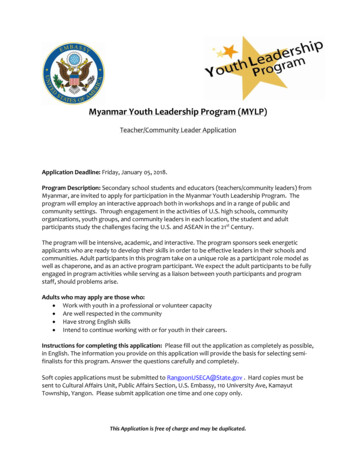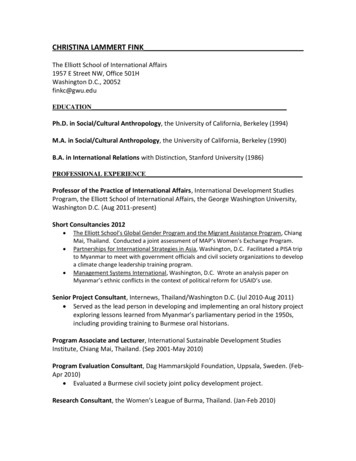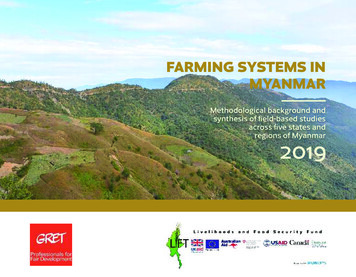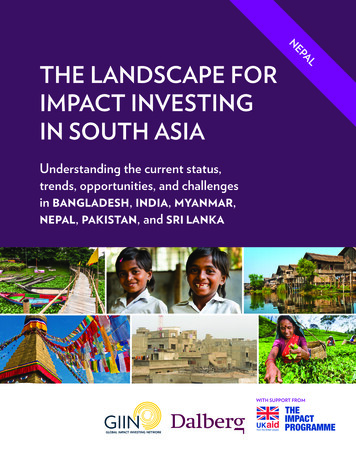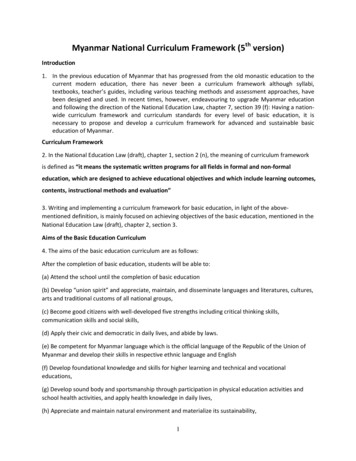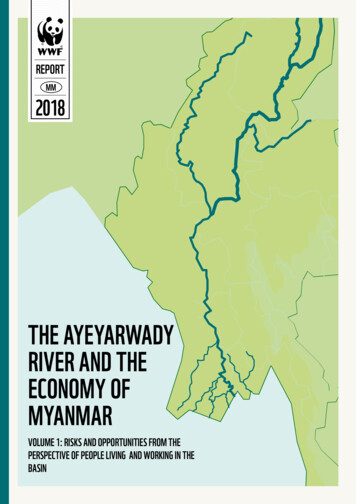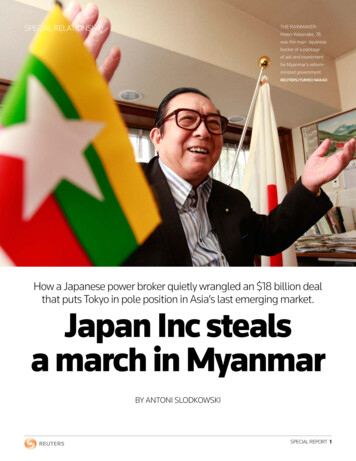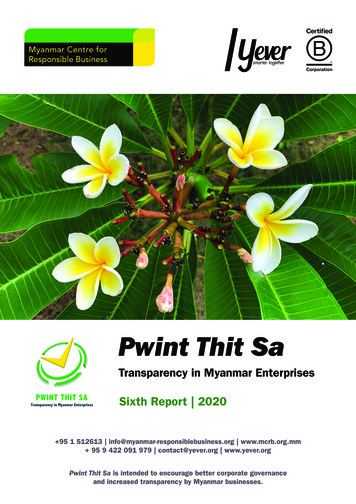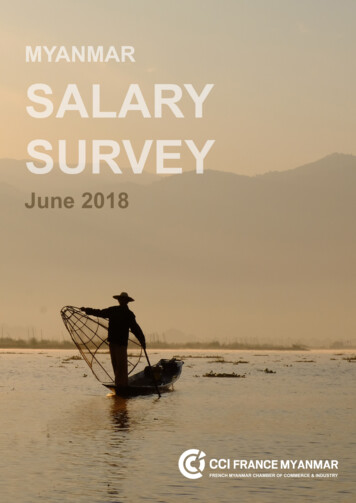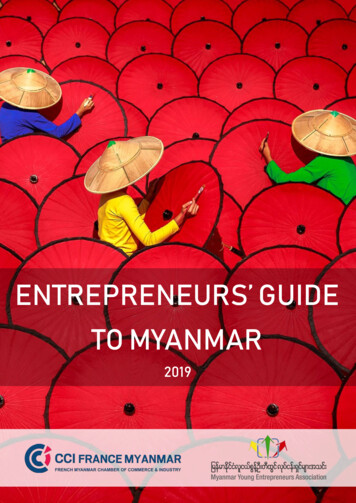
Transcription
ENTREPRENEURS’ GUIDETO MYANMAR2019
About CCI France Myanmar4Need a team?28CCI France Myanmar Editorial5General overview29About MYEA6How to find a team?30MYEA Editorial7What will it cost me?31Myanmar General Overview8Compliance32Taxes33Law considerations34What should I know before coming in2Myanmar?10Economy11Doing business in Myanmar36Infrastructures12Myanmar business culture37Visa and permit14How to prospect?38Local authorities16Managing daily life39How to set up a company?18Going international40What activity?19Find investors41What status and how to register?20Licenses and how to get them?21Contacts42Business incubators & accelerators43Contributors44How to settle down?22Find an office space23Connectivity25Equipment and IT Tools263
The French Business Association in Myanmar(Association Franco-Myanmar des Affaires), wasfounded in 1996, making it the first WesternChamber of Commerce in Myanmar. It officiallybecame CCI France Myanmar in 2013, two yearsafter the country started its democratic transition, and grew from 33 to 170 Members in only 5years, bringing together 15 nationalities (45%French, 40% Myanmar, 15% others).companies who want to enter the Myanmar market and/or operate in the country. In addition tomissions, delegations and market studies, it offerswage portage services as well as office space forrent, in all-inclusive attractive packages for newcomers. After successfully developing its BusinessCentre in Yangon, it has even opened a secondBusiness Centre in Mandalay, in 2018, the firstWestern Chamber to ever do so in the country.During that time it developed a large scope ofservices, which makes it the most dynamic anddiversified foreign Chamber in Myanmar, leadingto two international awards in 2017 from the International Chamber of Commerce and CCIFrance International. CCI France Myanmar noworganizes more than 40 events every year andalso regularly releases publications providingbusiness intelligence.In addition to that, CCI France Myanmar offers awide range of human resources services, startingwith recruitment services and training programstargeting employees and professionals who wishto improve their skills.But what makes CCI France Myanmar trulyunique is, above all, the services it provides toMyanmar offers many opportunities for entrepreneurs, whatever the sector in which theywork. But as in any other country, entrepreneurshave to face challenges which constitute threats totheir businesses, while often feeling isolated.In this context, CCI France Myanmar has decidedto create a Young Entrepreneurs Committee forits members. The main objective of this committee is to discuss the challenges faced byyoung entrepreneurs Members of CCI France44Finally, CCI France Myanmar is a key actor for thedevelopment of the French-Myanmar relations. Itworks in close partnership with Business France,with the French Embassy and with the FrenchForeign Trade Advisors.Myanmar and identify actions and projects whichcould be implemented by CCI France Myanmarand its Members to tackle these issues.This Committee has now decided to publish itsfirst Entrepreneurs’ guide to Myanmar to provideyou with insights and practical advice.Guillaume RebiereExecutive DirectorCCI France MyanmarBeing an entrepreneur is a challenge of everyinstant. It is not a career but a way of life.For many, it means starting a company with justan idea and few resources to see this fragileseed grow It means working 24/7 on their projects, forsaking nights, weekends and holidays,family life even, without being able to perceive asalary for months. It means having to struggle,very often in isolation, to find the information,the financial or material means, the supportneeded to see their idea flourish. Many times, italso means failing and then starting all overagain, while learning hard but useful lessonsfrom previous mistakes, like swimming againstthe current. Trial and error. Work, work, work.“Makers” who are creating the Myanmar of tomorrow, who are working against all odds tobring about a better future.First, we have created our Young EntrepreneursCommittee, which brings together the young entrepreneurs among our Members, so that theycan share information and good practices basedon their experiences. This is that knowledge andthese experiences that they now share with everyone in this guide.In addition to that, we have also launched ourYoung Entrepreneurs Awards, which rewardstartups in Myanmar, which deserve a specialrecognition for their excellence and/or for theirpositive impact.Some would say this is not a life. But for them,this is all their life. And they endure, persist, goon, because they believe in their ideas, becausethey believe in themselves, and because theybelieve that they can make a difference. Just likesome of their role models, who started in theirgarages, before making their start-ups becomesuccessful international groups: Bill Gates, SteveJobs, Elon Musk, Jack Ma, Jeff Bezos. Some ofthem changed the world forever, like ThomasEdison, who famously said after finally makingthe first light bulb work: “I have not failed. Ihave just found 10,000 ways that won’t work.Many of life’s failures are people who did notrealize how close they were to success whenthey gave up”.Finally, we are publishing this Entrepreneurs’Guide to Myanmar, in partnership with MYEA(Myanmar Young Entrepreneurs Association), inorder to help all the entrepreneurs operating inthe country. This document aims at offering allthe information they will need to create and develop their company: a summary of the legalframework, advice from those who were confronted to the same challenges, and tips on howto overcome them, based on personal experiences.Because of all that, CCI France Myanmar has decided to dedicate resources to support theseFinally, I would like to thank MYEA for their support and their contribution to this guide.This guide is of course a work in progress and weinvite all of you to join our Young EntrepreneursCommittee, so that you can share your own expertise with the community.5
The Myanmar Young Entrepreneurs Association (MYEA) has in the last yearsbecome one of the leading organizationsto foster the development of entrepreneurship in Myanmar. Established as aninformal group in 2008 and formally registered in 2012, the association now hasover 1800 members across the country.We are embedded in a wider network ofinternational entrepreneurship-related organizations. MYEA is the Myanmar member of the ASEAN Young Entrepreneurs Associations (AYEA), and through its affiliation with the Global Entrepreneurship Network (GEN) in charge of carrying out theGlobal Entrepreneurship Week (GEW) every year in November.Every two years, our members elect 70members to the Executive Committee,which in return appoints 30 members tothe Central Executive Committee. A Management Committee of 14 persons togetherwith the office team runs the day to dayoperations of the association.In all its activities, MYEA focuses on threekey aspects: Ecosystem development,member services, empowerment of regional associations.Through our close working relationshipwith the government, we provide valuable, data-backed inputs to various government agencies with the aim of improving the overall entrepreneurial ecosystemin Myanmar. MYEA identifies roadblocksand discusses with the government how toremove them to make starting and running businesses easier. The annual Myanmar Entrepreneurship Summit and GEWaim to raise awareness about entrepreneurship and inspire young people.66For our members, we provide a wide spectrum of services to meet the specificneeds for any stage of an entrepreneur’slifecycle. We offer seminars, pitchingevents, mentorship programs, networkingparties, excursions, business matchingevents, etc. As an association of volunteers, our members can be both beneficiaries and active contributors of the association at the same time.We truly believe that regional challengesare best addressed by entrepreneurs livingin that region. Therefore, instead of servicing our members through a centralizedstructure, we set up regional young entrepreneurs associations and empower themby the transferring knowledge, formatsand processes to them so that they canbest assist their regional entrepreneurs inreturn. So far, we have established five regional associations: Yangon Region, Mandalay Region, Shan State, Ayeyarwady Region and Mon State.MYEA strives to be the leading, recognizedorganization for the empowerment ofyoung entrepreneurs in Myanmar. Foranyone, who is not an entrepreneur yet,but who is planning to set up an own business in future, we offer an active participation in MYEA as an Associate Member. Ourmembers can join any of our working committees where they can not only activelycontribute, but also strengthen their ownnetworks and business relationships byworking together with other entrepreneurs.Dr. Aung ThuraPresidentMYEAWith Myanmar ranking low in almostevery cross-country comparison, it is oneof the hardest places to start and successfully grow a business. Therefore, entrepreneurs in Myanmar count amongthe most adaptable and resilient businesspeople in the world. While entrepreneursin other countries can focus on their corebusiness, entrepreneurs in Myanmarneed to cope with a lack of human resources, overarching bureaucracy, highcosts of doing business, missing access tocapital, weaknesses in the supply chainand infrastructure as well as lack of access to international markets.was written with the contribution of entrepreneurs and passes knowledge fromentrepreneurs to entrepreneurs.I would like to thank CCI France Myanmarfor their leadership in developing thisguide and the volunteers of MYEA forcontributing their knowledge and insights. We hope that with the help of thisguide, entrepreneurs can find solutionsand avoid mistakes in order to set theirbusinesses on a strong growth trajectory.Improving the entrepreneurial ecosystemis one of the key mandates of MYEA. Wedo this by guiding entrepreneurs throughdifferent stages of their lifecycle. WhenCCI France Myanmar approached us withthe idea to jointly develop this Entrepreneur’s Guide, we immediately loved the.This hands-on guide gives practical insights on what entrepreneurs will facewhen setting up their businesses. How dothey find an office? What licenses are required for which types of businesses?What needs to be considered when hiringpeople? Every entrepreneur faces suchquestions when starting and even laterwhen running a business. Why to reinvent the wheel if there are many entrepreneurs who have faced and solved issues of setting up a business? This guide7
labour force, its geographic location and finally an ever improving busi-ness enabling environment: new investment laws, new company law,IP law, consumer protection laws The opportunities are therefore numerous and varied thanks to a leapfrogging economy and a very high potential in all sectors. This makes itthe ideal place to start a company. Moreover, the increase of purchasepower in the middle class, helps trigger consumer’s interest in foreignimported goods.However, the country also suffers from weaknesses. Indeed, there islack of proper infrastructures, mainly due to the too rapid growth ofthe economy, and there is still a dire need to improve professionalskills. The fragility of the banking sector and a large illicit trade are alsoa problem in the country.Finally, the main threats to Myanmar are natural disasters (cyclones,earthquakes), and political instability in some parts of the country.Total Area676,578 square kmGrowth rate16.8% growthCapitalNay Pyi TawTHE PASSAGE TO SOUTH EAST ASIAInflation rate16.2% in 2018Myanmar can be considered geographically located at acrossroad between China and India, at the centre of ma-Population51.4 million of which70% live in rural areasjor Asian and Asean trading routes, since it also sharesborders with Thailand, Laos and Bangladesh.to democracy and has made several key reforms allowing15 States and Divisions135 Ethnic Groupsthe country to open itself to the world’s economy and toattract foreign investors.Key sectorsServices(42%)Industry(30%)Agriculture (28%)Myanmar’s strengths are mainly the abundance of natural resources, such as oil & gas, minerals, hydraulic re-Narrowing TradeDeficit in 2018but also the young18GovernanceNew Government elected in2015 led by the NationalLeague for Democracy partyMain citiesYangon (6 million)Mandalay (1.25 million)In 2011, Myanmar has engaged into an irreversible pathsources, agricultural products ,GDP per capita1approx. USD 1,400Source: World Bank, “Myanmar Economic Monitor”, December 20189
What should I know before coming in Myanmar?WHAT SHOULD I KNOWBEFORE COMING INMYANMAR?In 2011, after decades of isolation, Myanmar has decidedto open up its economy to attract foreign investments.Since then, the country has experienced an unprecedented growth. In 2018, the growth rate is estimated at 6.8%,higher than the average rate of other ASEAN countries.In December 2017, the New Myanmar Companies Lawwas passed by Parliament allowing foreign investors totake up to 35% of shares in local companies. The mostrecent move in 2018 is the Online Registration processfor companies that has been implemented on August1st. Overall, the regulatory framework has becomemore compliant with international standards and ensures an investment friendly climate. State OwnedBusinesses are also undergoing reforms since 2013 andare in process of privatization. Actual budget deficit has decreased to 2.7% in2017/2018 Public debt stands reasonably at 34.2% of GDP (mostlydue to the Paris Club Agreement that has cancelledmost of the debts in 2013) Account deficit is narrowing to 1.7 billion in2017/2018 A high volatility of the foreign exchange rate remainsIn 2018, the NLD-led government has launched theMyanmar Sustainable Development Plan (MSDP) torevamp the economy and to ensure a unique and global economic strategy for the country. The MSDP is implemented through 2 main agencies: DACU(Development Assistance Coordination Unit) and NECC(National Economic Coordination Committee).In just a few years, after removal of EU and US sanctions,the economic and legal environment has dramaticallyimproved: the government has initiated reforms whichare still ongoing. In 2016, the Foreign Investment Lawand the Myanmar Citizens Investment Law have mergedto form the Myanmar New Investment Law (MNIL).Oil & Gas Gas is mainly produced offshore from 4 main fields: Yada-Although Myanmar has to face strong challenges withthe ongoing crisis in Rakhine State, the economy remains robust and shows resilience.Tourism & Hospitalityna, Yetagun, Zawtika and Shwe. Gas production represents2 Bscf/day or 20 Bm3/year, 80% of which is exported toThailand and China. Directly impacted by the Rakhine crisis, the number of Western tourists have dropped dramatically. Arrivals from Asian Countries are increasing steadily since 2017 Gas exports represent a large share of the exports of Myanmar and of the Government budget (2.4% of GDP).thanks to visa exemptions (Thailand, Korea & Japan). With many hotel projects completed or close to completion, the supply is expecting to rise, pushing prices downwards.Construction & Real EstateTelecommunication Development in telecommunications remains a vital pillarin the evolution of Myanmar’seconomy and infrastructure. 4 telecom operators: MPTKDDI (historical operator andleading in market shares),Ooredoo, Telenor and MyTel. Financial services and education sectors are benefitingfrom the telecoms sectorthanks to a wider access toInternet services. Needs are huge: basic infrastructures are lacking. Infrastructure projects financed by international developmentagencies are under implementation in Mandalay and Yangon.Agriculture 25% of gross value in 2018and employing 49% of theworking population Focus on high end segment in the private sector. Challenging environment with unclear regulations regardingland title, underdeveloped financing system. With 35% of agricultural ex-Manufacturing / Garment Reinstatement of GSP in 2013 boosted garment exports to EU. It employs 730,000 people (83% women). Minimum daily wage being set at 4,800 MMK ( 3.12).ports, pulses and beans arethe main export crop. While70% of the production ofpulses and beans are exported to India, only a minorshare of this volume consistsof refined or processedgrains. Garment represented 65% of total exports to EU in 2016, and3% of Myanmar GDP in 2018.Healthcare Public health system delivery remains insufficient, but publicspending in health has increased from 0.19% to 0.8% of GDP. Private and public hospitals are booming but are facing also shortage of qualified specialists as well as medical management. 0.36 Physicians/1,000 people which is the lowest ratio in Asia.Energy Electrification ratio of approx. 40%. Low installed capacity ( 5.5 GW). 60% of power generation comes from hydropower. LNG to power solutions. Current major issue for the power sector is the tariff.Source: World Bank, “Myanmar Economic Monitor”, December 20181011
What should I know before coming in Myanmar?TRANSPORT NETWORKBUSINESS DEVELOPMENT ZONESBeing the second-largest country by area in SEA with a relatively wide road network that just 20% are paved, thecountry has vast investment opportunities in road network modernisation, construction of expanded roadways,such as elevated highways, improving access to the city via bridges to the South, East and West. Improvement ofregional airports has been an important part of the government’s plans in developing both the tourism andtransport. Urban transport infrastructures in major cities, whether in local/commuter rail, road, bridges and alternative transport options, are a priority as well.There are three Special Economic Zones (SEZ) in development:ROADSAIRPORTS Kyauk Phyu in Rakhine StateThe project initially began as a joint venture betweenthe Chinese and Burmese governments, but has sincetransitioned to private developers. Kyauk Phyu SEZ willbe accessible to the Shwe gas field in the Bay of Bengal.The oil and gas terminal was financed by the China National Petroleum Corporation. Dawei in the Thanintharyi RegionRoad and Highway network Asian Highway Routes - 4 in Myanmar: 2,907 kms ASEAN Highway Routes - 7 in Myanmar: 4,528 kms Transport Corridors of Greater Mekong Subregion— 5 Routes in Myanmar: North-South Corridor, East-West Corridor, Southern Corridor, Northern Corridor, Western CorridorRAILWAYSRailways network Total Route length 5,992.13kms Single Track 5,286.934 kms (88.23%) / Double Track705.196kms (11.76%) Bridges 11,818 Nos Tunnels 12 Nos Railway Stations 946 NosTrans-Asian Railways Network Yangon – Mandalay Mandalay - Lashio [Muse (border station) - Rueli(China)] Kalay - [Tamu (border station) - Jiribam (India)] Bago - Thanpyuzayat (Thailand) Thanpyuzayat – Ye Yangon (maritime connection)Proposed Projects in Myanmar Railways Yangon – Mandalay modernization work (617kms) Yangon city urban modernization and restorationworks (124.5 km) Mandalay - Myitkyina track (552 kms) Bago - Dawei track upgrading (507 kms) Tamu – Kalay – Segyi – Monywa – Mandalay lineproject (501 kms) Yangon – Pyay upgrading track (259 kms) National Railways Strategic PlanFurthermore there is a project of repowering of locomotives.123 CIQ airports: Bagan/Nyaung U – Heho – Dawei27 Domestic airportsAirport development projects Yangon International Airport — Accommodationimprovement. Mandalay International Airport — Development ofthe airport as major logistic hub. Bagan-Nyaung U Airport — Terminal Building upgrading as well as the safety operation standardlanding aids. Heho Airport — Terminal Building upgrading as wellas the safety operation standard landing aids. Thandwe Airport — Terminal Building upgrading. Dawei Airport — Upgrading domestic airport to international airport.SEAPORTS, DRYPORTS & TERMINALSPorts in Myanmar Yangon Region Yangon Ports Rakhine State Sittwe Port / Kyaukphu Port /Thandwe Port Ayeyarwady Region Pathein Port Mon State Mawlamyine Port Tanintharyi Region Kawthaung Port / MyeikPort / Dawei PortDeep Sea Port ProjectsPotential areas to be developed as Deep Sea Ports: Dawei Special Economic Zone together with DeepSea Port at Tanintharyi Region in the South Coast. Kyaukpyu Deep Sea Port at Rakhine State in theWest Coast. Kalagauk Deep Sea Port, between Mawlamyineand Ye Region at the South Coast. Westport Deep Sea Port at Ngayoke Bay,Ayeyarwaddy Region.The government has been exploring ways to restartdevelopment of the US 8 billion Dawei SEZ, which hasbeen suspended since 2013 after developer Italian-ThaiDevelopment Company withdrew from a 2008 agreement due to financial constraints. Negotiations are being made with Japan to get them involved in the project. Thilawa in Yangon RegionThe Thilawa SEZ is located on 23 Km southeast of Yangon. It is the very first large-scale SEZ in Myanmar. TheZone, which totals 2,400-acre, is being developed inphases under Myanmar-Japan Thilawa DevelopmentLtd.TELECOMMUNICATIONSThere has been a telecoms boom that has dramaticallychanged the physical and technological landscape ofthe country since the sector was opened to foreigncompetition in 2014. Myanmar’s mobile market hasexperienced very rapid growth from 2013 to 2018,driven by the entry of three new competitors in themarket, increasing the number of operators from onlyone to four. This has dramatically increased marketcompetition. The mobile broadband market is drivenby increasingly faster speeds as mobile operators rollout 4G and eventually 5G networks.2021. The Ministry of Energy and Electricity has committed that by 2030, 12% of the energy mix will comefrom renewables (mainly solar).In September 2018, ADB announced a USD300 millionloan to expand Myanmar’s national electricity grid inseven regions and states: Yangon, Ayeyarwaddy, Bagoand Tanintharyi regions and Mon, Kayin and Rakhinestates.Electricity tariff remains a real issue to be solved ascurrent tariffs do not reflect the real cost of production.Regarding the Oil & Gas sector, the national oil & gascompany MOGE (Myanmar Oil & Gas Enterprise) produces Oil & Gas on shore and is a partner of the foreigncompanies operating in Myanmar. It also acts as theregulator of the sector under the guidance of the Ministry of Electricity and Energy (MOEE).Although Myanmar is one of the oldest oil producers inthe world with the production of the onshoreYenangyaung field by the Burmah Oil Co in 1886, Myanmar has shifted to be mainly a gas producer today.Gas is mainly produced offshore from 4 main‘historical’ fields. Yadana, Yetagun, Zawtika and Shwe.80% of gas production is exported to Thailand and China. The Yadana field, operated by Total E&P Myanmar,is the main gas field in Myanmar, producing around800 Mscf/d or8 Bm3/year. It supplies around half ofthe gas consumed in Myanmar and 15% of the gas consumed in Thailand, where ¾ of its production is exported. Zawtika is operated by PTT E&P (Thailand) andShwe field is operated by Daewoo (Korea). The Fourthforeign operator is Petronas (Malaysia).In 2013 – 2014, additional onshore and offshore blockswere allocated to foreign and JV companies, attractingmore investment in this sector. Total E&P has beenawarded Block A6 that has been since 2017 under production. Unlike the Yadana field, most of the gas supplywill be used for the domestic market. The MOEE isplanning to launch another series of tenders on additional blocks in the beginning of 2019.ENERGYMyanmar has an installed capacity of 5.5 GW, which isa very low ratio. 60% of power generation comes fromhydraulic resources (the hydro power potential is considered to be near 100 GW) and the rest comes mainlyfrom gas power plants. In 2018, approximately 40% ofthe population have access to electricity. Additionalinstalled capacity is planned in the next few years.In January 2018, a few Notice to Proceed (NTP) willbring 3000 MW of additional power to the country,mainly through the production of LNG and some rehabilitation of existing plants. Regarding renewables,more than 500 MW of solar power will be injected by13
What should I know before coming in Myanmar?In theory the immigration process must be the following. The first entry must be on a Business Visa. Once arrivedin Myanmar, the applicant must apply for the Foreigner’s Registration Certificate (FRC) and long Term Stay Permit. After obtaining the FRC and long Term Stay permit, a Guest Resident Report must be filed at the TownshipImmigration Department where the applicant will reside in order to get the Residence Permit Notice and to residing legally in Myanmar.However, immigration rules are ever changing and each application might be considered differently. In practice, itappears that the process for a Stay Permit can be subject to numerous ad hoc requests from the reviewing authorities. Additionally, FRC procurement is often cumbersome and final certificate is difficult to obtain.Foreign workers in Myanmar must ensure that a valid Business Visa is held and manage carefully their stay duration and visa renewal.Documents I need for a Business Visa Recommendation letter from the employer, including details about the type of business, purpose of visit, ap-plicant’s name, passport details, position in company, and intended entry and exit dates; Invitation letter from a Myanmar registered company on its official letterhead; Guarantor from the Myanmar registered company, who is the one officially inviting the applicant. The guaran-tor must be the Managing Director or Owner of the company, and must give a copy of the Myanmar companyregistration certificate. The guarantor may be contacted by the immigration authorities during the applicationprocess; Visa application form; Two recent colour photographs with white background size 35mm x 45mm;VISA Passport valid for at least six months and a copy of the passport details pageTo enter Myanmar, all visitors must have a valid passport and an entry visa.Main types of visa forbusiness purposeLength of stayHow to apply28 daysOnline (https://evisa.moip.gov.mm)Myanmar EmbassyVisa on arrivalBusiness Visa(single entry)70 daysOnline (https://evisa.moip.gov.mm)Myanmar EmbassyVisa on arrivalBusiness Visa(multi-entries for 3 months /6 months / 1 year)70 days(can extend stay period inImmigration department)Myanmar EmbassyMyanmar Diplomatic mission for renewalEducation Visa(single entry)70 daysMyanmar EmbassyMyanmar Diplomatic mission for renewalEducation Visa(multi-entries for 3 months /6 months /1 year)70 days(can extend stay period inImmigration department)Myanmar EmbassyMyanmar Diplomatic mission for renewalTourist VisaEmployment Visa70 days(can apply for extension)WORK PERMITThe Work Permit was introduced under the 2012Myanmar Foreign Investment Law (FIL). Companies under FIL or under the Myanmar SpecialEconomic Zone Law (MSEZL) can apply for workpermits for foreigners in managerial or supervisory roles, or for those holding technical skills.Together with a Stay Permit and a Multiple Journey Special Re-entry Visa it gives the possibilityto the worker to stay in Myanmar beyond 70days and to exit and re-enter the country on thesame visa.Notice that since January 2016 the multiple entries business visa for one year allows foreignersto stay in Myanmar beyond the 70 days to theentire year extending in immigration department.Myanmar EmbassyMyanmar Diplomatic mission for renewalFrench citizens willing to apply a visa to enter in Myanmar territory have many ways to carry out their application as detailed below.For the time being, most foreign workers in Myanmar are using a Business Visa to enter and live in the country.Employment Visa is relevant for workers, managers, consultants and other skilled employees. Education visa isrelevant for teachers, university professors or students invited by a Myanmar University to attend and/or to giveclasses. A multiple entry Business Visa is usually acquired if the applicant has already had at least two single entry Business Visas and has not violated any immigration laws. Each different case can be considered individuallyby Myanmar consulate.French citizens living abroad can also apply visa from the closer embassy of the Republic of the Union of Myanmar. The list of Diplomatic missions of Myanmar is available online on the website of the Ministry of ForeignAffairs : http://www.mofa.gov.mm.14Since January 2016 and the notification relating to visa published by the Ministry of Labour, Immigration and Population, the multiple entries Business Visa allows foreigners to stay in Myanmar for one year. They do not need toexit and return after a stay of 70 days by extending their stay period in the department of Immigration, as theywould under the previous notification.RESIDENCE PERMIT(Permanent Residence)Since 2014, foreigners married to Myanmar citizenor living in Myanmar at least three years can applyto a Permanent Residency. According to The Myanmar Times at that time, “the vice president saidthe system would enable scholars, experts, intellectuals and investors from other countries, aswell as former Myanmar citizens, to contribute tonational development.” Before 2014, foreignerinvestors, experts and former citizens’ could stayin Myanmar only with a limited duration visa.In order to be able to apply for a permanent residency in Myanmar, applicants must have lived aminimum of three consecutive years in Myanmarand must justify their position of "High Skilled potential". Once obtained, a Permanent Residentpermit duration is 5 years, renewable. Holders of aPermanent Residence card do not require a visa(except in the event of more than 24 consecutivemonth stay abroad) to enter Myanmar.Permanent Residence is not commonly used asBusiness Visa is offering the best compromise.DisclaimerThe content of this article is intended only as a general overview of the matters referenced and is not intended t
The French usiness Association in Myanmar (Association Franco-Myanmar des Affaires), was founded in 1996, making it the first Western hamber of ommerce in Myanmar. It officially became I France Myanmar in 2013, two years after the country started its democratic transi-tion, and grew from 33 to 170 Members in only 5
